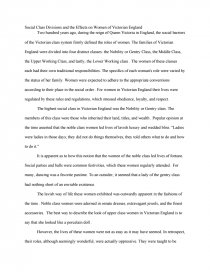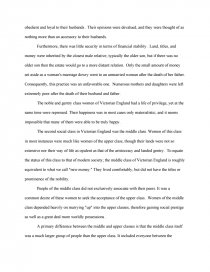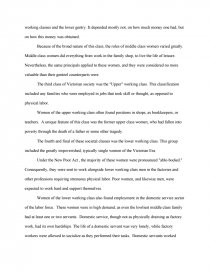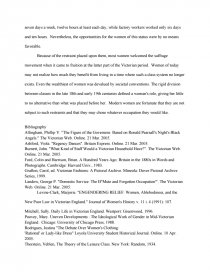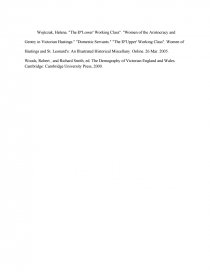Social Class Divisions and the Effects on Women of Victorian England
Essay by review • November 24, 2010 • Research Paper • 1,371 Words (6 Pages) • 1,841 Views
Essay Preview: Social Class Divisions and the Effects on Women of Victorian England
Social Class Divisions and the Effects on Women of Victorian England
Two hundred years ago, during the reign of Queen Victoria in England, the social barriers of the Victorian class system firmly defined the roles of women. The families of Victorian England were divided into four distinct classes: the Nobility or Gentry Class, the Middle Class, the Upper Working Class, and lastly, the Lower Working class . The women of these classes each had their own traditional responsibilities. The specifics of each woman's role were varied by the status of her family. Women were expected to adhere to the appropriate conventions according to their place in the social order . For women in Victorian England their lives were regulated by these rules and regulations, which stressed obedience, loyalty, and respect.
The highest social class in Victorian England was the Nobility or Gentry class. The members of this class were those who inherited their land, titles, and wealth . Popular opinion at the time asserted that the noble class women led lives of lavish luxury and wedded bliss. "Ladies were ladies in those days; they did not do things themselves, they told others what to do and how to do it."
It is apparent as to how this notion that the women of the noble class led lives of fortune. Social parties and balls were common festivities, which these women regularly attended. For many, dancing was a favorite pastime. To an outsider, it seemed that a lady of the gentry class had nothing short of an enviable existence.
The lavish way of life these women exhibited was outwardly apparent in the fashions of the time . Noble class women were adorned in ornate dresses, extravagant jewels, and the finest accessories. The best way to describe the look of upper class women in Victorian England is to say that she looked like a porcelain doll .
However, the lives of these women were not as easy as it may have seemed. In retrospect, their roles, although seemingly wonderful, were actually oppressive. They were taught to be obedient and loyal to their husbands . Their opinions were devalued, and they were thought of as nothing more than an accessory to their husbands.
Furthermore, there was little security in terms of financial stability . Land, titles, and money were inherited by the closest male relative; typically the older son, but if there was no older son then the estate would go to a more distant relation. Only the small amount of money set aside as a woman's marriage dowry went to an unmarried woman after the death of her father. Consequently, this practice was an unfavorable one. Numerous mothers and daughters were left extremely poor after the death of their husband and father.
The noble and gentry class women of Victorian England had a life of privilege, yet at the same time were repressed. Their happiness was in most cases only materialistic; and it seems impossible that many of them were able to be truly happy.
The second social class in Victorian England was the middle class. Women of this class in most instances were much like women of the upper class, though their lands were not so extensive nor their way of life as opulent as that of the aristocracy and landed gentry. To equate the status of this class to that of modern society; the middle class of Victorian England is roughly equivalent to what we call "new money." They lived comfortably, but did not have the titles or prominence of the nobility.
People of the middle class did not exclusively associate with their peers. It was a common desire of these women to seek the acceptance of the upper class. Women of the middle class depended heavily on marrying "up" into the upper classes, therefore gaining social prestige as well as a great deal more worldly possessions .
A primary difference between the middle and upper classes is that the middle class itself was a much larger group of people than the upper class. It included everyone between the working classes and the lower gentry. It depended mostly not, on how much money one had, but on how this money was obtained.
Because of the broad nature of this class, the roles of middle class women varied greatly. Middle class women did everything from work in the family shop, to live the life of leisure. Nevertheless, the same principals applied to these women, and they were considered no more valuable than their genteel counterparts were.
The third class of Victorian society was the "Upper" working class. This classification included any families who were employed in jobs that took skill or thought, as opposed to physical labor.
Women of the upper working class often found positions in shops, as bookkeepers, or teachers. A unique feature of this class was the former upper class women, who had fallen into poverty through the death of a father or some other tragedy.
The fourth and final of these societal classes was the lower working class. This group included the greatly impoverished, typically single women of the Victorian Era.
Under the New Poor Act , the majority of these women were pronounced "able-bodied." Consequently, they were sent to work alongside lower working class men in the factories and other professions requiring strenuous physical labor. Poor women, and likewise men, were expected to work hard and support themselves.
Women
...
...
